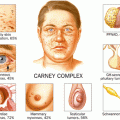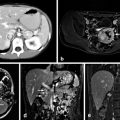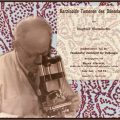Karl Adolph von Basedow.

Fig. 1
Map of Germany, indicating Dessau, von Basedow’s hometown, and Merseburg, the town where he practiced as a family physician and was laid to rest
Little is known about von Basedow’s youth. He had two sisters and one brother [1]. Basedow went to school in Dessau and then studied medicine at the University of Halle (south of Dessau), where he received his doctorate of medicine and surgery in January 1821 at the age of 22. His thesis, which was written in Latin, addressed a new method of lower leg amputation. After spending 2 years on the surgical services at two famous hospitals in Paris, Hòtel de Dieu and Charité, von Basedow obtained his license certifying him as a general practitioner, surgeon, and obstetrician in June 1822. In the summer of 1822, at the age of 23, Basedow settled in Merseburg (Fig. 1), a district town of about 8000 inhabitants, and began practicing as a general physician.
On April 23, 1823, von Basedow married Louise Friederike Scheuffelhuth, the daughter of a district notary. They had three daughters and one son; their youngest daughter died at 6 months of age from tuberculosis [1]. Von Basedow was described as an affectionate father, taking time to play music with his daughters. He loved not only listening to music and concerts but also hiking, was an avid hunter and fisherman, and enjoyed socializing [2]. The evening soirées at the von Basedow’s were quite popular in the community.
In 1841, von Basedow was appointed Royal Medical Counselor, and in 1848, he was selected from among eight other candidates as state physician/chief medical officer (“Kreisphysikus”) for the district of Merseburg, a position he held until his untimely death. After pricking his finger while performing an autopsy on a patient who died of typhus or spotted fever, von Basedow developed a fever and died 3 days later of sepsis on April 11, 1854, at the age of 55 [2, 3]. Von Basedow was buried in the Sixtus Cemetery in Merseburg on Good Friday, April 14, 1854.
As a physician, von Basedow had a reputation as a kind, talented, and skilled family doctor with extensive knowledge of all aspects of medical practice who also possessed a social conscience [2]. He was the “round-the-clock” physician for “the town and country,” caring for not only aristocrats but also the poorest, sometimes without seeking payment. In 1831, he voluntarily helped to fight the cholera epidemic in Magdeburg; an invaluable experience that he would later draw from when cholera afflicted Merseburg. He performed the autopsies of many of his patients, including his youngest child. The comprehensive care provided by von Basedow as a general practitioner during these times is truly remarkable.
Von Basedow was not only an astute and dedicated physician but he was also extremely dedicated to public health issues. He sought to end the “unchristian breast-feeding by paid wet nurses,” introduced testing of drinking water, and, after observing the detrimental effects of arsenic-containing paints (“Schweinfurter Grün,” “poison green”), vehemently fought to ban paints containing arsenic [1, 2].
From a scientific standpoint, von Basedow became a member of the Medical Society of Leipzig in 1838 and was recognized as a very accomplished scholar with excellent insight and foresight. Similar to his clinical practice, he had extensive, broad, and diverse scientific interests, which were documented in approximately 60 publications. The majority of his contributions addressed topics related to surgery, internal medicine, and obstetrics and gynecology. However, articles also focused on diseases of the eye, ear, nose, and throat, dermatology, neurology, and pediatrics, reflecting von Basedow’s extensive and different scientific interests [4].
Von Basedow’s most significant contribution to medicine was the first description of “Basedow disease” in the German language on March 28, 1840, entitled “Exophthalmos due to hypertrophy of the cellular tissue in the orbit” [5]. In this seminal article, von Basedow describes “…there appeared an eminent protrusion of the eyeballs, which by the way were absolutely healthy and had a completely full sight. In spite of this, the sick woman was sleeping with open eyes and had a frightening appearance.” This initial publication was followed by several others and the phrase “glotzaugen-cachexie” or “google eyes cachexia” was coined [6, 7]. These publications represent von Basedow’s observations of four patients over periods ranging from 2 to 11 years. In his 1840 publication, von Basedow masterfully described the relationship between three characteristic symptoms: exophthalmos, palpitations, and goiter [5]. In 1851, these three cardinal symptoms characterizing the disease became known as “Merseburg triad.”
Stay updated, free articles. Join our Telegram channel

Full access? Get Clinical Tree








